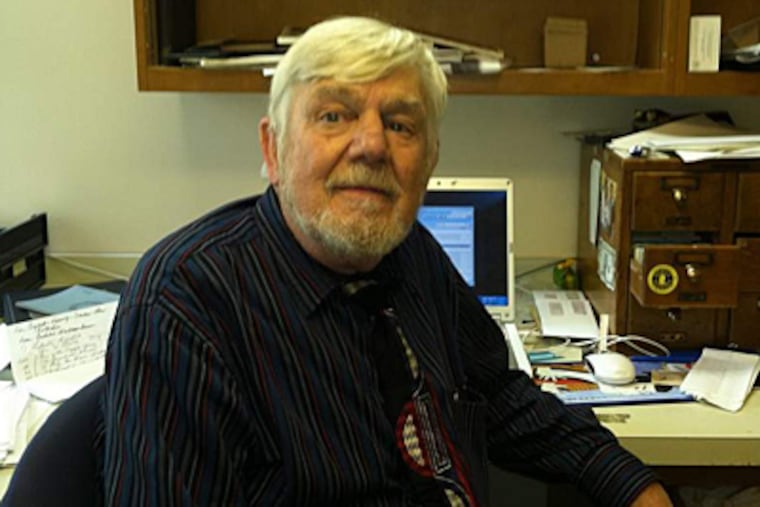African American scholar Lapsansky resting on his archival laurels

Philip Lapsansky, sweep of white hair curling over his brow, settles into his lair, a small, paper-stuffed, book-strewn, binder-choked office on the second floor of the Library Company of Philadelphia overlooking Locust Street.
Lapsansky has toiled here for more than four decades, usually clad in sedately gaudy plaid shirts and art deco-esque ties (on this day the shirt is a navy blue, black, gold, winey red-striped number with "matching" serpentine-patterned red, white and black checked cravat). He sits on a high stool — physically echoing Dickens' hyper-knowledgeable Mr. Gradgrind — and describes briefly what led him into the generally quiet world of archivists.
Lapsansky's archival world, however, is anything but quiet, and his role in it has been anything but retiring. Yet now, after 41 years of organizing and building one of the greatest collections of African American archival materials in the world, after helping innumerable scholars and researchers locate the critical source that pulls their work together or blows it up or sends it careering off into another direction, he is retiring. For real.
More than a few historians and scholars are lamenting this moment. The Library Company threw a party for him last week, noting that Lapsansky, 71, had been instrumental in focusing attention on its considerable collection of African Americana, and therefore has been a key force in bringing about "a turning point in how people explored this history."
"Previously, African American literature and art were considered inconsequential to understanding our nation's history," a Library Company statement says, adding that "Lapsansky brought to light a wide array of previously overlooked historical sources and helped change the minds of many."
Carol Smith-Rosenberg, professor emerita of history, American culture, and women's studies at the University of Michigan, puts it succinctly: "He taught us all to look beyond traditional historical categories, read sources we all too often ignored."
"Talking to Phil is like talking to the archive itself," says Richard S. Newman, professor of history at Rochester Institute of Technology.
Lapsansky is unfazed by comments like that — and there are many contained in a 179-page volume put together by the Library Company, Phil Lapsansky: Appreciations.
"Who in hell are these people talking about?" he said, shaking his head, perched on his stool. "I feel that the smartest scholars in the world came in, and I talked to them and learned from them. I never thought about the specific gravity, the impact of what I put out there."
Lapsansky arrived in 1971 with an intense interest in African American history and culture born of his involvement in the civil rights struggle of the 1960s, and with an acute intellectual curiosity, but without any archival expertise beyond a love of books.
He was hired by former Library Company director Edwin Wolf 2d, who decided it was time to go beyond talking about black history and actually "do something about it."
So Lapsansky prowled through the vast collection — accumulated since the Library Company's 1731 founding by Benjamin Franklin as the nation's first subscription library — to locate materials related to black life and history.
Several diamond mines of documents, letters, pamphlets, images, books, and other items were hidden in plain view on the shelves, but no one had ever bothered to shine a light on them, organize them, and describe what they were.
Over more than two years, Lapsansky searched the shelves — he calls it "stack ratting" — ultimately producing Afro-Americana, 1553-1906: Author Catalog of the Library Company of Philadelphia and the Historical Society of Pennsylvania, a bibliographical record that helped make the city a mecca for scholars of black history.
"Just rummaging through the stacks," he called it. "It was very pleasurable."
Most important, he stayed on permanently at the Library Company, reading, acquiring material when possible, and gathering a particularly unusual and important repository of images related to black life.
"In those [early] years, I'm not aware of any other institution in the rare book field going … after this stuff. It was the unwanted child of academia," he said. "Now we have African American studies all over the place. It's required in the Philadelphia school system for high school. It's taken off as a topic."
Activism during the 1950s and '60s pushed the change, Lapansky says. African Americans returning from World War II were "not content" with what they found at home after fighting for democracy. "People wanted to know. They started looking at a whole new set of questions about the nature of race and slavery."
Over his tenure, and with a modest budget, Lapsansky has been able to acquire quite a few "charming acquisitions," as he calls them. The collection now numbers more than 13,000 items.
And while he will no longer physically be at the Library Company on a daily basis, he will be "on call," ready to provide emergency services for scholars teetering at the edge of confusion.
But so far he has no writing planned for himself.
"I've been able to be a fatuous poobah of sorts," Lapsansky said. "I don't want to jeopardize my dilettante status."